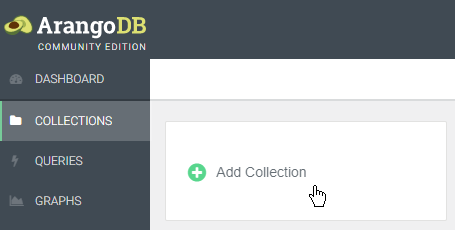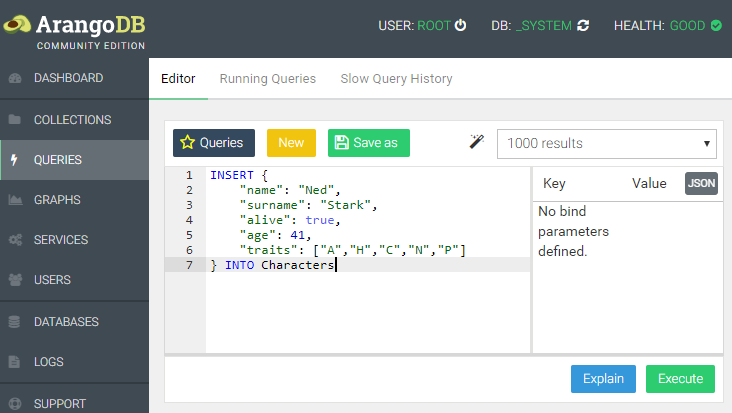ArangoDB v3.4 reached End of Life (EOL) and is no longer supported.
This documentation is outdated. Please see the most recent version here: Latest Docs
CRUD
Create documents
Before we can insert documents with AQL, we need a place to put them in - a collection. Collections can be managed via the web interface, arangosh or a driver. It is not possible to do so with AQL however.


Click on COLLECTIONS in the web interface, then Add Collection and type
Characters as name. Confirm with Save. The new collection should appear
in the list.
Next, click on QUERIES. To create the first document for collection with AQL, use the following AQL query, which you can paste into the query textbox and run by clicking Execute:

INSERT {
"name": "Ned",
"surname": "Stark",
"alive": true,
"age": 41,
"traits": ["A","H","C","N","P"]
} INTO Characters
The syntax is INSERT document INTO collectionName. The document is an object
like you may know it from JavaScript or JSON, which is comprised of attribute
key and value pairs. The quotes around the attribute keys are optional in AQL.
Keys are always character sequences (strings), whereas attribute values can
have different types:
- null
- boolean (true, false)
- number (integer and floating point)
- string
- array
- object
Name and surname of the character document we inserted are both string values. The alive state uses a boolean. Age is a numeric value. The traits are an array of strings. The entire document is an object.
Let’s add a bunch of other characters in a single query:
LET data = [
{ "name": "Robert", "surname": "Baratheon", "alive": false, "traits": ["A","H","C"] },
{ "name": "Jaime", "surname": "Lannister", "alive": true, "age": 36, "traits": ["A","F","B"] },
{ "name": "Catelyn", "surname": "Stark", "alive": false, "age": 40, "traits": ["D","H","C"] },
{ "name": "Cersei", "surname": "Lannister", "alive": true, "age": 36, "traits": ["H","E","F"] },
{ "name": "Daenerys", "surname": "Targaryen", "alive": true, "age": 16, "traits": ["D","H","C"] },
{ "name": "Jorah", "surname": "Mormont", "alive": false, "traits": ["A","B","C","F"] },
{ "name": "Petyr", "surname": "Baelish", "alive": false, "traits": ["E","G","F"] },
{ "name": "Viserys", "surname": "Targaryen", "alive": false, "traits": ["O","L","N"] },
{ "name": "Jon", "surname": "Snow", "alive": true, "age": 16, "traits": ["A","B","C","F"] },
{ "name": "Sansa", "surname": "Stark", "alive": true, "age": 13, "traits": ["D","I","J"] },
{ "name": "Arya", "surname": "Stark", "alive": true, "age": 11, "traits": ["C","K","L"] },
{ "name": "Robb", "surname": "Stark", "alive": false, "traits": ["A","B","C","K"] },
{ "name": "Theon", "surname": "Greyjoy", "alive": true, "age": 16, "traits": ["E","R","K"] },
{ "name": "Bran", "surname": "Stark", "alive": true, "age": 10, "traits": ["L","J"] },
{ "name": "Joffrey", "surname": "Baratheon", "alive": false, "age": 19, "traits": ["I","L","O"] },
{ "name": "Sandor", "surname": "Clegane", "alive": true, "traits": ["A","P","K","F"] },
{ "name": "Tyrion", "surname": "Lannister", "alive": true, "age": 32, "traits": ["F","K","M","N"] },
{ "name": "Khal", "surname": "Drogo", "alive": false, "traits": ["A","C","O","P"] },
{ "name": "Tywin", "surname": "Lannister", "alive": false, "traits": ["O","M","H","F"] },
{ "name": "Davos", "surname": "Seaworth", "alive": true, "age": 49, "traits": ["C","K","P","F"] },
{ "name": "Samwell", "surname": "Tarly", "alive": true, "age": 17, "traits": ["C","L","I"] },
{ "name": "Stannis", "surname": "Baratheon", "alive": false, "traits": ["H","O","P","M"] },
{ "name": "Melisandre", "alive": true, "traits": ["G","E","H"] },
{ "name": "Margaery", "surname": "Tyrell", "alive": false, "traits": ["M","D","B"] },
{ "name": "Jeor", "surname": "Mormont", "alive": false, "traits": ["C","H","M","P"] },
{ "name": "Bronn", "alive": true, "traits": ["K","E","C"] },
{ "name": "Varys", "alive": true, "traits": ["M","F","N","E"] },
{ "name": "Shae", "alive": false, "traits": ["M","D","G"] },
{ "name": "Talisa", "surname": "Maegyr", "alive": false, "traits": ["D","C","B"] },
{ "name": "Gendry", "alive": false, "traits": ["K","C","A"] },
{ "name": "Ygritte", "alive": false, "traits": ["A","P","K"] },
{ "name": "Tormund", "surname": "Giantsbane", "alive": true, "traits": ["C","P","A","I"] },
{ "name": "Gilly", "alive": true, "traits": ["L","J"] },
{ "name": "Brienne", "surname": "Tarth", "alive": true, "age": 32, "traits": ["P","C","A","K"] },
{ "name": "Ramsay", "surname": "Bolton", "alive": true, "traits": ["E","O","G","A"] },
{ "name": "Ellaria", "surname": "Sand", "alive": true, "traits": ["P","O","A","E"] },
{ "name": "Daario", "surname": "Naharis", "alive": true, "traits": ["K","P","A"] },
{ "name": "Missandei", "alive": true, "traits": ["D","L","C","M"] },
{ "name": "Tommen", "surname": "Baratheon", "alive": true, "traits": ["I","L","B"] },
{ "name": "Jaqen", "surname": "H'ghar", "alive": true, "traits": ["H","F","K"] },
{ "name": "Roose", "surname": "Bolton", "alive": true, "traits": ["H","E","F","A"] },
{ "name": "The High Sparrow", "alive": true, "traits": ["H","M","F","O"] }
]
FOR d IN data
INSERT d INTO Characters
The LET keyword defines a variable with name data and an array of objects
as value, so LET variableName = valueExpression and the expression being a
literal array definition like [ {...}, {...}, ... ].
FOR variableName IN expression is used to iterate over each element of the
data array. In each loop, one element is assigned to the variable d.
This variable is then used in the INSERT statement instead of a literal
object definition. What it does is basically:
INSERT {
"name": "Robert",
"surname": "Baratheon",
"alive": false,
"traits": ["A","H","C"]
} INTO Characters
INSERT {
"name": "Jaime",
"surname": "Lannister",
"alive": true,
"age": 36,
"traits": ["A","F","B"]
} INTO Characters
...
Note: AQL does not permit multiple INSERT operations that target the same
collection in a single query.
It is allowed as body of a FOR loop however, inserting multiple documents
like we did with above query.
Read documents
There are a couple of documents in the Characters collection by now. We can
retrieve them all using a FOR loop again. This time however, we use it to
go through all documents in the collection instead of an array:
FOR c IN Characters
RETURN c
The syntax of the loop is FOR variableName IN collectionName. For each
document in the collection, c is assigned a document, which is then returned
as per the loop body. The query returns all characters we previously stored.
Among them should be Ned Stark, similar to this example:
{
"_key": "2861650",
"_id": "Characters/2861650",
"_rev": "_V1bzsXa---",
"name": "Ned",
"surname": "Stark",
"alive": true,
"age": 41,
"traits": ["A","H","C","N","P"]
},
The document features the four attributes we stored, plus three more added by
the database system. Each document needs a unique _key, which identifies it
within a collection. The _id is a computed property, a concatenation of the
collection name, a forward slash / and the document key. It uniquely identies
a document within a database. _rev is a revision ID managed by the system.
Document keys can be provided by the user upon document creation, or a unique
value is assigned automatically. It can not be changed later. All three system
attributes starting with an underscore _ are read-only.
We can use either the document key or the document ID to retrieve a specific
document with the help of an AQL function DOCUMENT():
RETURN DOCUMENT("Characters", "2861650")
// --- or ---
RETURN DOCUMENT("Characters/2861650")
[
{
"_key": "2861650",
"_id": "Characters/2861650",
"_rev": "_V1bzsXa---",
"name": "Ned",
"surname": "Stark",
"alive": true,
"age": 41,
"traits": ["A","H","C","N","P"]
}
]
Note: Document keys will be different for you. Change the queries accordingly.
Here, "2861650" is the key for the Ned Stark document, and "2861653" for
Catelyn Stark.
The DOCUMENT() function also allows to fetch multiple documents at once:
RETURN DOCUMENT("Characters", ["2861650", "2861653"])
// --- or ---
RETURN DOCUMENT(["Characters/2861650", "Characters/2861653"])
[
[
{
"_key": "2861650",
"_id": "Characters/2861650",
"_rev": "_V1bzsXa---",
"name": "Ned",
"surname": "Stark",
"alive": true,
"age": 41,
"traits": ["A","H","C","N","P"]
},
{
"_key": "2861653",
"_id": "Characters/2861653",
"_rev": "_V1bzsXa--B",
"name": "Catelyn",
"surname": "Stark",
"alive": false,
"age": 40,
"traits": ["D","H","C"]
}
]
]
See the DOCUMENT() function
documentation for more details.
Update documents
According to our Ned Stark document, he is alive. When we get to know that he
died, we need to change the alive attribute. Let us modify the existing document:
UPDATE "2861650" WITH { alive: false } IN Characters
The syntax is UPDATE documentKey WITH object IN collectionName. It updates the
specified document with the attributes listed (or adds them if they don’t exist),
but leaves the rest untouched. To replace the entire document content, you may
use REPLACE instead of UPDATE:
REPLACE "2861650" WITH {
name: "Ned",
surname: "Stark",
alive: false,
age: 41,
traits: ["A","H","C","N","P"]
} IN Characters
This also works in a loop, to add a new attribute to all documents for instance:
FOR c IN Characters
UPDATE c WITH { season: 1 } IN Characters
A variable is used instead of a literal document key, to update each document.
The query adds an attribute season to the documents’ top-level. You can
inspect the result by re-running the query that returns all documents in
collection:
FOR c IN Characters
RETURN c
[
[
{
"_key": "2861650",
"_id": "Characters/2861650",
"_rev": "_V1bzsXa---",
"name": "Ned",
"surname": "Stark",
"alive": false,
"age": 41,
"traits": ["A","H","C","N","P"],
"season": 1
},
{
"_key": "2861653",
"_id": "Characters/2861653",
"_rev": "_V1bzsXa--B",
"name": "Catelyn",
"surname": "Stark",
"alive": false,
"age": 40,
"traits": ["D","H","C"],
"season": 1
},
{
...
}
]
]
Delete documents
To fully remove documents from a collection, there is the REMOVE operation.
It works similar to the other modification operations, yet without a WITH clause:
REMOVE "2861650" IN Characters
It can also be used in a loop body to effectively truncate a collection:
FOR c IN Characters
REMOVE c IN Characters
Note: re-run the insert queries at the top with all character documents before you continue with the next chapter, to have data to work with again.

